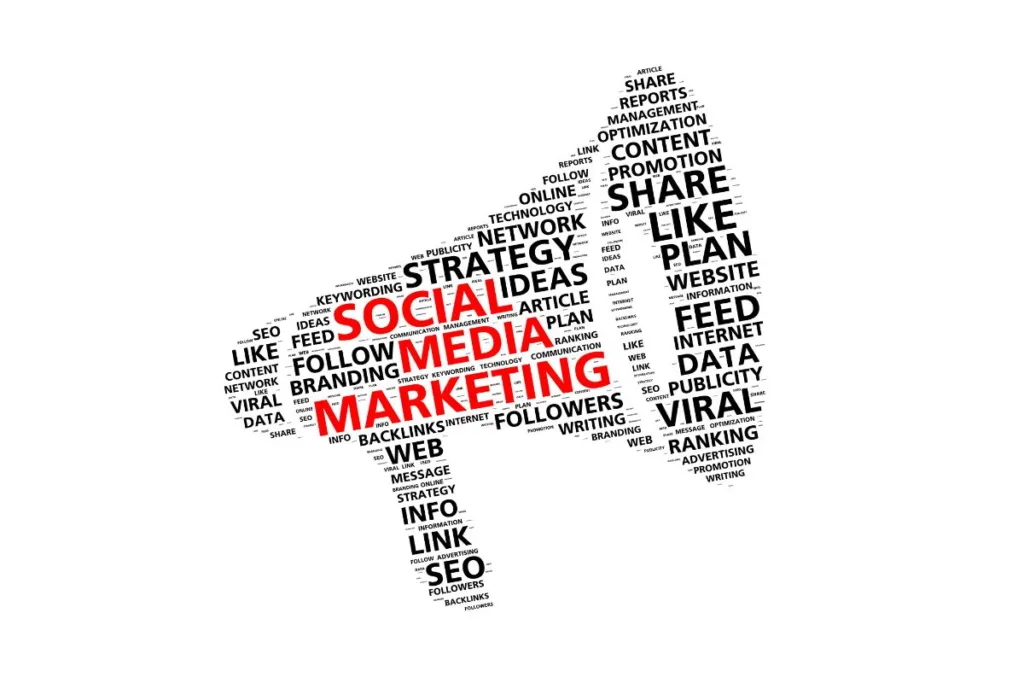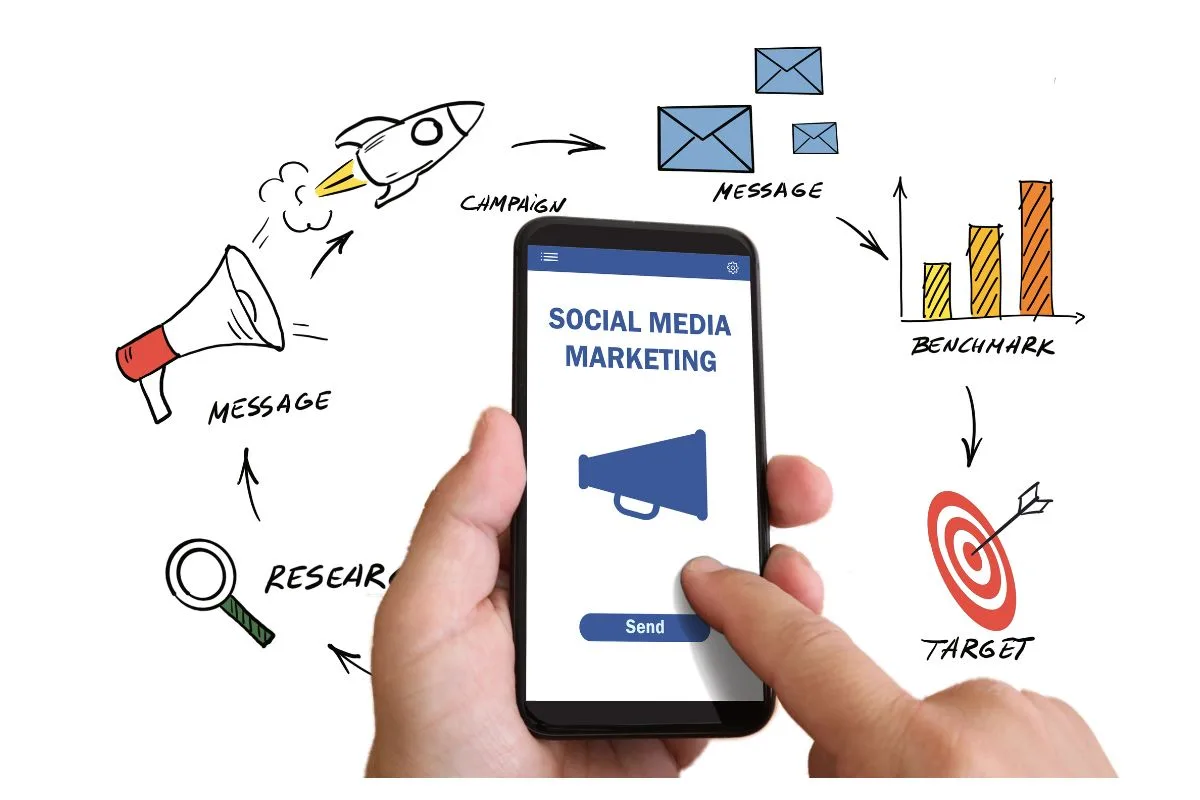Social media marketing involves using social media platforms to connect with your audience, build brand awareness, and drive business goals. There are various types of social media marketing strategies, each catering to different objectives.
Definition of Social Media Marketing
Social media marketing is a digital marketing strategy that involves leveraging various social media platforms to connect with a target audience, foster brand awareness, drive website traffic, and accomplish marketing objectives. It encompasses a range of activities, including content creation, community engagement, advertising, and analytics, with the goal of building a strong online presence.
Table of Contents
Types of social media marketing
1) Content Marketing:
Content marketing on social media involves creating and sharing high-quality, valuable content to educate, entertain, or inform your audience. This can include blog posts, articles, videos, and infographics. There are various types of content marketing. The goal is to build brand authority and engage followers. Additionally, content marketing fosters a sense of community as users share and discuss the content, enhancing brand visibility.

2) Social Media Advertising:
Social media advertising involves creating and running paid campaigns on platforms like Facebook, Instagram, or LinkedIn. Advertisers can target specific demographics, interests, and behaviors to reach a defined audience and achieve specific marketing objectives. Social media ads can be highly targeted, allowing for precise audience segmentation and increased ROI compared to traditional advertising channels.
3) Influencer Marketing:
Influencer marketing leverages individuals with a significant following on social media to promote products or services. Influencers can provide authentic recommendations, reaching their audience in a more personalized way. This form of marketing also facilitates the creation of user-generated content, as influencers and their followers share their experiences with the promoted products or services.
4) User-Generated Content (UGC) Campaigns:
UGC campaigns encourage your audience to create and share content related to your brand. This not only builds a sense of community but also serves as authentic endorsements, boosting trust and brand credibility. UGC can be repurposed in marketing materials, showcasing real customers and their experiences with your products or services.
5) Social Media Contests and Giveaways:
Hosting contests or giveaways on social media platforms is an effective way to increase engagement and grow your audience. Participants often need to share, like, or comment, increasing the visibility of your brand. Additionally, these events create excitement and a sense of urgency, driving immediate action and participation.
6) Community Building:
Community building involves creating a space for your audience to connect and engage with each other and your brand. Regular interactions, responding to comments, and facilitating discussions help foster a sense of belonging. Brands can also use community forums or groups to gather feedback, conduct market research, and involve customers in product development.
7) Customer Service and Support:
Social media platforms are used as channels for customer service, allowing brands to respond to inquiries, solve issues, and provide timely support. This transparency can enhance customer satisfaction and loyalty. Additionally, positive customer service interactions on social media contribute to a positive brand image and can be publicly acknowledged, serving as testimonials.
8) Social Listening:
Social listening involves monitoring social media channels for mentions of your brand, competitors, or industry keywords. It provides insights into public sentiment, allowing you to respond to trends or address concerns proactively. Social listening not only aids in reputation management but also provides valuable market intelligence that can inform strategic decision-making.
9) Live Video Streaming:
Live video streaming on platforms like Facebook Live or Instagram Live enables real-time interaction with your audience. This can be used for product launches, Q&A sessions, behind-the-scenes glimpses, and more. Live videos create a sense of urgency and exclusivity, encouraging users to engage immediately and providing an authentic and unscripted connection with the audience.
10) Employee Advocacy:
Employee advocacy encourages employees to share and promote the brand on their personal social media accounts. This leverages their networks and authenticity to amplify your brand’s reach. Employee advocacy also humanizes the brand by showcasing the people behind the company, fostering a stronger connection with the audience.
11) Social Media Analytics:
Social media analytics involves using data and metrics to measure the performance of your social media efforts. Analyzing key metrics helps you understand what is working, refine your strategy, and demonstrate the ROI of your social media activities. Metrics can include engagement rates, click-through rates, conversion rates, and sentiment analysis.
12) Geotargeting:
Geotargeting allows you to tailor social media content and ads to specific geographic locations. This is useful for reaching a local audience, promoting location-specific events, or adapting messages to cultural nuances. Geotargeting enhances relevance, ensuring that your content resonates with users in specific regions.
13) Social Media for E-commerce:
Integrating social media into e-commerce strategies involves using features like shopping tags or product catalogs. This allows businesses to showcase and sell products directly on social platforms, streamlining the customer journey. Social commerce takes advantage of the seamless experience social media platforms provide for discovering and purchasing products.
14) Employee Engagement:
Employee engagement on social media involves featuring employees, sharing their stories, and showcasing the human side of the brand. This adds a personal touch and helps build a positive company culture. Employee engagement initiatives can include “day in the life” posts, employee spotlights, and participation in industry discussions, showcasing the expertise within the organization.
15) Storytelling:
Storytelling on social media is about using narratives to create an emotional connection with your audience. This can involve sharing brand origin stories, customer success stories, or behind-the-scenes content to make your brand more relatable. Storytelling builds brand identity and helps users connect with the values and personality of the brand, fostering long-term relationships.
CONCLUSION :- These social media marketing strategies, when implemented effectively, contribute to a comprehensive and dynamic approach to engaging with your audience, building brand loyalty, and achieving business objectives.
Advantages and Disadvantages of social media marketing
Advantages of Social Media Marketing:
1. Increased Brand Visibility:
Social media platforms offer a vast audience, providing businesses with an opportunity to increase brand visibility and reach a global audience. This exposure is particularly beneficial for brand recognition and attracting potential customers who may not have encountered the brand through other channels.
2. Enhanced Customer Engagement:
Direct interactions with customers allow for real-time engagement, feedback, and relationship-building, fostering a sense of community around the brand. This engagement contributes to brand loyalty, as customers feel a personal connection to the business.
3. Cost-Effectiveness:
Compared to traditional advertising, social media marketing is often more cost-effective, especially for small businesses with limited budgets. Many social media platforms offer free accounts and affordable advertising options, making it accessible to businesses of all sizes.
4. Precise Audience Targeting:
Social media platforms provide robust targeting options, allowing businesses to reach specific demographics based on interests, behaviors, and demographics. This precision targeting ensures that marketing efforts are directed towards the most relevant audience, improving the efficiency of campaigns.
5. Real-Time Feedback:
Businesses can receive immediate feedback on products, services, and campaigns, enabling quick adjustments to marketing strategies. Real-time feedback is invaluable for businesses looking to stay agile and responsive to customer needs and preferences.
6. Increased Website Traffic:
Engaging content shared on social media can drive traffic to the business website, increasing the potential for conversions and sales. Social media serves as a gateway, guiding users from platforms to the business’s online presence, where they can explore products or services in more detail.
7. Access to Global Markets:
Pro: Social media breaks down geographical barriers, enabling businesses to reach and engage with audiences worldwide. This global accessibility is especially advantageous for businesses with products or services that have broad appeal beyond local markets.
8. Brand Authenticity:
Pro: Social media allows businesses to humanize their brand, showcasing the people behind the company and sharing authentic stories. This transparency and authenticity build trust with the audience, fostering a positive perception of the brand.
Disadvantages of Social Media Marketing:
1. Risk of Negative Comments:
Con: Negative comments and feedback can occur publicly, requiring businesses to manage and address issues promptly to maintain a positive brand image. Businesses need to have effective crisis management strategies in place to handle negative publicity.
2. Time-Consuming:
Effectively managing social media accounts, creating content, and engaging with the audience can be time-consuming, especially for small businesses with limited resources. A consistent and active presence is crucial, necessitating a commitment of time and effort.
3. Algorithm Changes Impacting Organic Reach:
Social media algorithms are subject to change, and updates can impact organic reach, requiring businesses to adapt their strategies accordingly. This dynamic nature of algorithms means that what worked in the past may not yield the same results in the future.
4. Potential for Miscommunication:
Miscommunication or misinterpretation of messages can occur, and businesses must be vigilant in conveying their intended messages clearly. Clear communication is essential to avoid misunderstandings that could negatively impact the brand’s reputation.
5. Evolution of Platform Features:
Constant changes in platform features and policies may require businesses to stay informed and adjust their strategies to leverage new opportunities. Staying up-to-date with platform changes is essential to ensure that marketing efforts align with the latest features and functionalities.
6. Competition for Attention:
With the abundance of content on social media, businesses face stiff competition for users’ attention, making it challenging to stand out. Creating high-quality, engaging content is essential to capture and retain the audience’s attention amid the noise of competing messages.
7. Dependency on Platform Policies:
Businesses are subject to the policies of social media platforms, and changes in these policies can impact content visibility and overall strategy. Relying solely on social media platforms without diversifying marketing channels can expose businesses to risks associated with policy changes.
8. Potential for Information Overload:
Users may be overwhelmed by the volume of content on social media, leading to reduced attention spans and the potential for important messages to be overlooked. Crafting concise and impactful content becomes crucial to cut through the clutter and resonate with the audience.
Common Questions and Answers related to Social Media Marketing
What is the Role of Social Media in Digital Marketing?
Social media plays a pivotal role in digital marketing by serving as a dynamic platform for customer interaction, content distribution, brand promotion, and real-time engagement. It enables businesses to connect with their audience directly, humanize their brand, and adapt marketing strategies based on real-time feedback.
How to Measure the Success of Social Media Marketing Campaigns?
Success can be measured through key performance indicators (KPIs) such as engagement metrics (likes, comments, shares), click-through rates (CTR), conversion rates, and return on investment (ROI). Analyzing these metrics provides insights into the effectiveness of campaigns and areas for improvement.
What Platforms are Best for Social Media Marketing?
The choice of platforms depends on various factors, including target audience demographics, business goals, and the type of content being shared. For instance, visual content may perform well on platforms like Instagram and Pinterest, while B2B businesses may find LinkedIn more effective.
Is Influencer Marketing Effective for Small Businesses?
Influencer marketing can be effective for small businesses as it provides access to established audiences, builds credibility through influencer endorsements, and can be more cost-effective than traditional advertising. Collaborating with influencers aligned with the brand’s values and target audience enhances authenticity.
What Role Does Analytics Play in Social Media Marketing?
Analytics tools play a crucial role in social media marketing by providing insights into audience behavior, campaign performance, and areas for improvement. Analyzing data helps businesses make informed decisions, refine strategies, and demonstrate the impact of social media efforts.
Is Paid Advertising Necessary for Social Media Success?
The role of paid advertising depends on various factors, including budget constraints and specific marketing goals. While organic efforts are valuable for building a genuine audience, paid advertising can provide targeted and measurable results, especially for reaching specific demographics or promoting time-sensitive offers.

